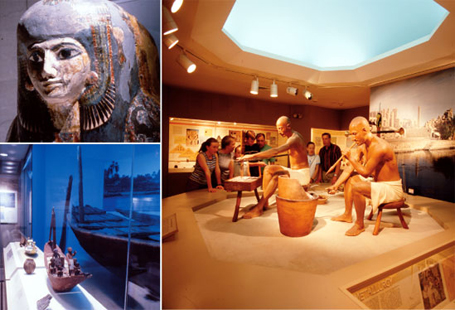Back

Above Photos: Mindy Mcnaugher Photo:
Karen meyers
The “bog mummies” of northeastern Europe aren’t
the only mummies at rest and on view at Carnegie Museum
of Natural History. The museum’s Walton Hall
of Ancient Egypt is the permanent home to a collection of Egyptian
mummies dating as far back as 664 B.C., surrounded by more
than 600 other ancient Egyptian artifacts, some dating
back to 3,100 B.C.
While Egyptian artifacts have been a
hallmark of the museum since Andrew Carnegie purchased
a mummy and its coffin
in 1896, it wasn’t until February 10, 1990, that
an entire exhibit hall devoted to the exploration of Egypt’s
ancient civilizations opened to the Pittsburgh public.
Aside from the hall’s mummies, its most popular artifact
was, and still is, a 30-foot royal funerary boat—“The
Carnegie Boat”—excavated from the pyramid complex
of a pharaoh named Senwosret III who reigned more than
3,800 years ago. Located about 20 miles south of Cairo,
the site was unearthed by French archaeologist Jacques
de Morgan in 1894-95. Word of the rare find got back to
an astute Andrew Carnegie, who quickly acquired the boat
for his new museum. To this day, it’s one of only
six such crafts ever discovered.
The hall’s two human
mummies—an adult male
who lived sometime between 1 and 200 A.D., and a child
who lived about 300 B.C.—are accompanied by the mummies
of a cat, an Ibis bird, a Nile Perch, and a juvenile crocodile.
Scientists learned what was inside all these tightly wound
packages the modern way: they x-rayed each one, and those
x-rays are on display in the hall.
“
Ancient Egyptians considered certain animals sacred to
the gods,” explains Dave Watters, curator of Anthropology
for the museum, “and mummified animals were often
presented as offerings to those gods.”
The most prominent
exhibit in The Walton Hall of Ancient Egypt doesn’t
have anything to do with mummies or death, but rather how
creative and industrious the ancient
Egyptians were in life: it’s a diorama that shows
life-size Egyptian craftsmen making glass beads for jewelry.
Surrounding the lifelike scene are hundreds of artifacts
from daily life thousands of years ago, such as ceramic
and stone vessels, jewelry, and tools.
Still, it’s
the stuff of death—the burial rituals,
the ancient artifacts entombed with the remains of an ancient
people—that seem to fascinate us the most, and visitors
to The Walton Hall of Ancient Egypt aren’t disappointed.
Hardly a day goes by that excited kids and curious adults
don’t wait in line to crawl through a short tunnel
leading to the hall’s replica tomb, which includes
a model of one of Andrew Carnegie’s first Egyptian
purchases—a mummy’s coffin.
Back
| Top |